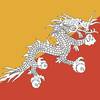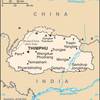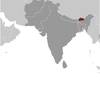Bhutan [+]Compare [E]dit [H]istory
Aliases: Druk Gyalkhap, Druk Yul, Kingdom of BhutanObject «Bhutan» was created due to
Add new object to «Bhutan» or move existing objects here.
Object «Bhutan» has attributes [Show empty attributes][Hide empty attributes]
| Attribute | Value |
|---|---|
| Geography | |
| Area | 38,394 km² |
| Continent | Asia |
| Land area | 38,394 km² |
| Water area | 0 km² |
| Land boundaries | 1,136 km |
| Border countries |
|
| Coastline | 0 km |
| Mean elevation | 2,220 m |
| Lowest point | 97 m |
| Highest point | 7,570 m |
| People | |
| Population | 782,318 |
| Official languages |
|
| Religion | Lamaistic Buddhist |
| Government | |
| Long country name | Kingdom of Bhutan |
| Short country name | Bhutan |
| Long local name | Druk Gyalkhap |
| Short local name | Druk Yul |
| Former name | Add |
| Government type | Constitutional monarchy |
| Capital | Thimphu |
| Economy | |
| GDP (PPP) | 7,205,000,000 USD |
| GDP (OER) | 2,405,000,000 USD |
| GDP (real growth rate) | 7.4 % |
| GDP - per capita (PPP) | 9,000 USD |
| Gross national saving | 40.4 % of GDP |
| Labor force | 397,900 |
| Unemployment rate | 3.2 % |
| Population below poverty line | 12 % |
| Budget revenues | 655,300,000 USD |
| Budget expenditures | 737,400,000 USD |
| Military expenditures | Add |
| Taxes and other revenues | 27.2 % of GDP |
| Budget surplus or deficit | -3.4 % of GDP |
| Public debt | 106.3 % of GDP |
| Inflation rate | 5.8 % |
| Central bank discount rate | 6 % |
| Commercial bank prime lending rate | 15 % |
| Stock of narrow money | 993,500,000 USD |
| Stock of broad money | 993,500,000 USD |
| Stock of domestic credit | 1,535,000,000 USD |
| Market value of publicly traded shares | 401,400,000 USD |
| Current account balance | -547,000,000 USD |
| Exports | 554,600,000 USD |
| Imports | 1,025,000,000 USD |
| Reserves of foreign exchange and gold | 1,206,000,000 USD |
| External debt | 2,671,000,000 USD |
| National currency | ngultrum |
| National currency (code) | BTN |
| National currency (symbol) | Nu. |
| National currency rate to USD | 64.97 |
Following Britain’s victory in the 1865 Duar War, Britain and Bhutan signed the Treaty of Sinchulu, under which Bhutan would receive an annual subsidy in exchange for ceding land to British India. Ugyen WANGCHUCK - who had served as the de facto ruler of an increasingly unified Bhutan and had improved relations with the British toward the end of the 19th century - was named king in 1907. Three years later, a treaty was signed whereby the British agreed not to interfere in Bhutanese internal affairs, and Bhutan allowed Britain to direct its foreign affairs. Bhutan negotiated a similar arrangement with independent India in 1949. The Indo-Bhutanese Treaty of Friendship returned to Bhutan a small piece of the territory annexed by the British, formalized the annual subsidies the country received, and defined India's responsibilities in defense and foreign relations. Under a succession of modernizing monarchs beginning in the 1950s, Bhutan joined the UN in 1971 and slowly continued its engagement beyond its borders. In 2005, King Jigme Singye WANGCHUCK unveiled the draft of Bhutan's first constitution - which introduced major democratic reforms - and held a national referendum for its approval. The King abdicated the throne in 2006 in favor of his son, Jigme Khesar Namgyel WANGCHUCK. In 2007, India and Bhutan renegotiated their treaty, eliminating the clause that stated that Bhutan would be "guided by" India in conducting its foreign policy, although Thimphu continues to coordinate closely with New Delhi. In 2008, Bhutan held its first parliamentary election in accordance with the constitution. Bhutan experienced a peaceful turnover of power following a parliamentary election in 2013, which resulted in the defeat of the incumbent party. In 2018, the incumbent party again lost the parliamentary election. Of the more than 100,000 ethnic Nepali - predominantly Lhotshampa - refugees who fled or were forced out of Bhutan in the 1990s, about 6,500 remain displaced in Nepal.
Similar objects
Most often compared with
Everyone can something to edit or add.
There was one edit, no edits waiting approval. Last edited by jmcdermott(9391), Sep 16, 2019 (62 fields were changed)
Help · Contact us · Disclaimer · Contributors · Developers · Donate


